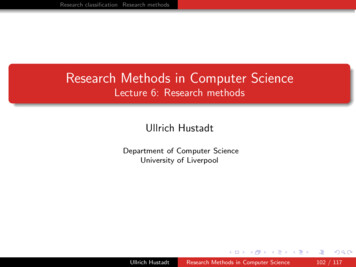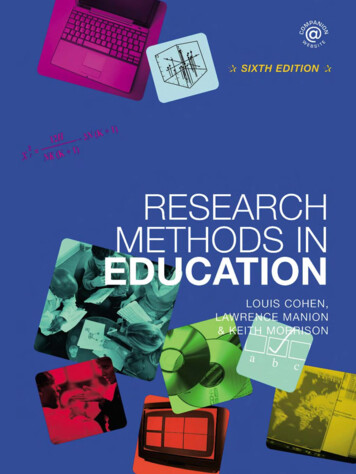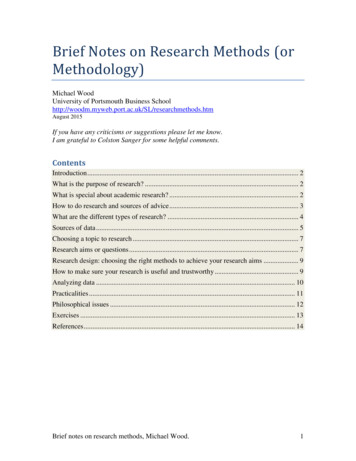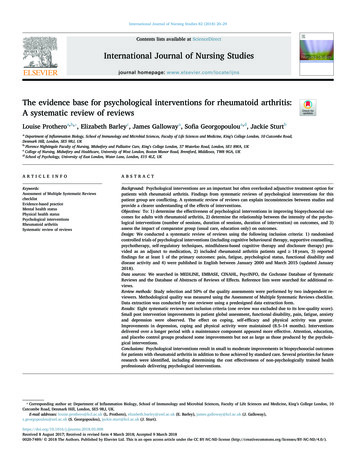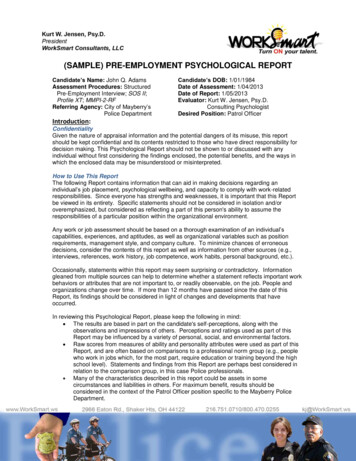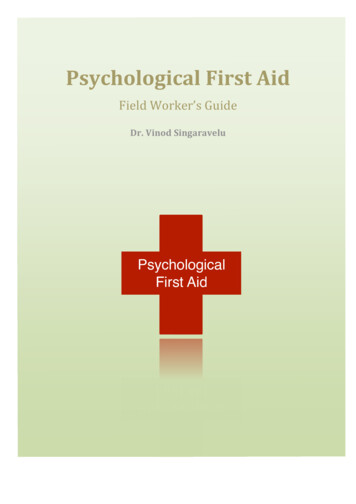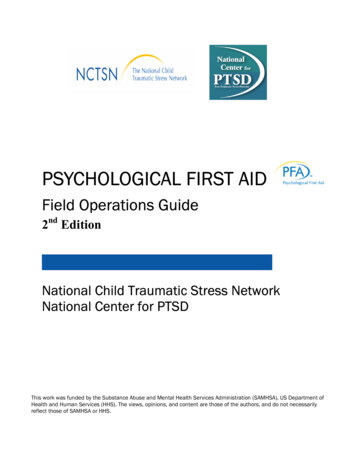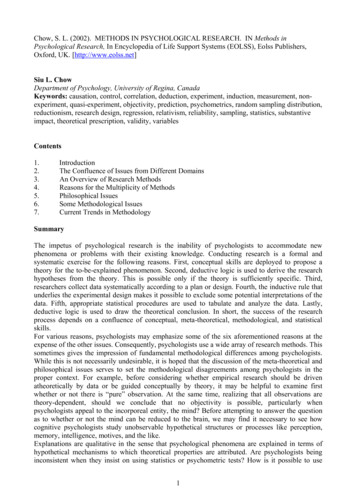
Transcription
Chow, S. L. (2002). METHODS IN PSYCHOLOGICAL RESEARCH. IN Methods inPsychological Research, In Encyclopedia of Life Support Systems (EOLSS), Eolss Publishers,Oxford, UK. [http://www.eolss.net]Siu L. ChowDepartment of Psychology, University of Regina, CanadaKeywords: causation, control, correlation, deduction, experiment, induction, measurement, nonexperiment, quasi-experiment, objectivity, prediction, psychometrics, random sampling distribution,reductionism, research design, regression, relativism, reliability, sampling, statistics, substantiveimpact, theoretical prescription, validity, variablesContents1.2.3.4.5.6.7.IntroductionThe Confluence of Issues from Different DomainsAn Overview of Research MethodsReasons for the Multiplicity of MethodsPhilosophical IssuesSome Methodological IssuesCurrent Trends in MethodologySummaryThe impetus of psychological research is the inability of psychologists to accommodate newphenomena or problems with their existing knowledge. Conducting research is a formal andsystematic exercise for the following reasons. First, conceptual skills are deployed to propose atheory for the to-be-explained phenomenon. Second, deductive logic is used to derive the researchhypotheses from the theory. This is possible only if the theory is sufficiently specific. Third,researchers collect data systematically according to a plan or design. Fourth, the inductive rule thatunderlies the experimental design makes it possible to exclude some potential interpretations of thedata. Fifth, appropriate statistical procedures are used to tabulate and analyze the data. Lastly,deductive logic is used to draw the theoretical conclusion. In short, the success of the researchprocess depends on a confluence of conceptual, meta-theoretical, methodological, and statisticalskills.For various reasons, psychologists may emphasize some of the six aforementioned reasons at theexpense of the other issues. Consequently, psychologists use a wide array of research methods. Thissometimes gives the impression of fundamental methodological differences among psychologists.While this is not necessarily undesirable, it is hoped that the discussion of the meta-theoretical andphilosophical issues serves to set the methodological disagreements among psychologists in theproper context. For example, before considering whether empirical research should be drivenatheoretically by data or be guided conceptually by theory, it may be helpful to examine firstwhether or not there is “pure” observation. At the same time, realizing that all observations aretheory-dependent, should we conclude that no objectivity is possible, particularly whenpsychologists appeal to the incorporeal entity, the mind? Before attempting to answer the questionas to whether or not the mind can be reduced to the brain, we may find it necessary to see howcognitive psychologists study unobservable hypothetical structures or processes like perception,memory, intelligence, motives, and the like.Explanations are qualitative in the sense that psychological phenomena are explained in terms ofhypothetical mechanisms to which theoretical properties are attributed. Are psychologists beinginconsistent when they insist on using statistics or psychometric tests? How is it possible to use1
quantitative data as evidential support for qualitative theories? How do psychologists generalizefrom their data that are collected in an artificial setting to real-life phenomena? What is the rationaleof experimentation in psychological research? How can psychologists assess their research?1. IntroductionConducting research differs from informal gathering of information in that researchers collect datasystematically so as to answer a well-defined question. The research is systematic if data arecollected in strict accordance with a predetermined plan or design. The question is well defined if itoriginates from an unambiguous theoretical statement. These requirements seem reasonable forstudying tangible and durable phenomena (e.g. a floating vessel). However, they would seem at firstblush impossible for psychologists to conduct research in view of the following challenges.First, much of what interests psychologists is not observable in the way physical objects like chairsand cars are tangible. To skeptics, the incorporeal nature of mental phenomena (e.g. memory,drives, thinking, etc.) precludes them from being observed or measured. This, in turn, renders itimpossible to study them systematically. Second, individual human beings are unique andunpredictable in a way physical objects are not. It would seem inappropriate to strive for generalstatements, let alone functional laws or explanatory theories that apply to all human beings withoutexception. Third, unlike inanimate objects whose nature is relatively durable, psychologicalphenomena are colored by fleeting wants, desires, fears, and the like. Is it possible to studyinconstant phenomena systematically and objectively? Fourth, while it may be possible to study acomplex object bit by separate bit if the object is the sum of its components, this analyticalapproach is inappropriate for psychology because individual character has a unity that is more thanthe sum of its parts. For example, taking away Smith’s motives (if it were possible), psychologistsare no longer studying Smith. Conversely, it is not meaningful to talk about Smith without takinginto account Smith’s motives. Fifth, human affairs are value laden. Can, or should, psychologicalresearch be objective?This introduction to the research methods used in psychology begins with how the confluence ofpsychologists’ conceptual, logical, meta-theoretical, theoretical, and statistical skills serves toensure that research data are collected systematically to answer well-defined questions. Next is asummary of the multiplicity of research methods at the disposal of psychologists. The philosophicaland methodological assumptions underlying the aforementioned reservations about psychologicalresearch are considered before the discussion of how research findings are assessed. The discussionconcludes with an affirmation of the primacy and importance of theoretical considerations.2. The Confluence of Issues from Different DomainsA description of various skills implicated in conducting research provides the backdrop forsubsequent discussion of various philosophical and methodological issues implicated inpsychological research. It is also essential for understanding why psychologists do things the waythey do.2.1. Conceptual IssuesPsychologists begin a research project when confronted with a phenomenon that cannot be readilyaccommodated by the existing conceptual scheme. For example, why does the normally reservedJoe become an ardent activist who participates in protests? Why do drivers sometimes “see” the redtraffic light after they are half a block past the intersection (see Experimentation in Psychology-Rationale, Concepts and Issues)? The first step in conducting research is the conceptual task ofcoming up with a conjecture that makes sense of the to-be-understood phenomenon. Note that thephenomenon exists before the research, and that the research is about an explanation of thephenomenon, not the phenomenon itself (for a discussion of the analogous distinction between the2
interpretation of test scores and the test scores themselves in The Construction and Use ofPsychological Tests and Measures).In Psychologist A’s view, Joe’s new found activism is the expression of his previously suppressedaggressiveness. However, Psychologist B considers the change as a sign that Joe has overcome acrippling inhibition. Can the two explanations be true at the same time? Which one is correct if theyare incompatible? At the same time, both may be incorrect. For example, Joe’s change may bebrought about by a newly acquired insight into social policies. It is a sophisticated conceptual taskto design appropriate research to sort out these questions.Psychologist C may suggest that Joe’s previous reserve was, in fact, aloofness, which camouflagedJoe’s aggressiveness. Such a stance raises the conceptual issue as to how it is possible thataggressiveness can account for two apparently unrelated, if not opposite, phenomena (aloofness andactivism). A related conceptual issue is whether or not aggressiveness would be evoked to explainJoe’s reserve had his demeanor been characterized as shy instead of aloof. That is, the direction ofthe research depends on how the phenomenon is conceptualized in the first place.Native speakers of a language are not necessarily good at explaining what makes an utterancegrammatical in the native language. This is because the ability to analyze and talk about naturallanguage is a meta-linguistic skill different from the ability to use the language. Likewise, adifferent conceptual skill is required to explicate or analyze the rationale of psychological research,namely, a familiarity with some logical rules and relationships, as well as some methodologicalissues.2.2. Logical Rules and RelationshipsPsychologists dispute whether a scientific psychology is deductive or inductive. In contrast,satirizing some psychologists’ scientific aspiration as mere scientism (an exaggerated faith in thepropriety or efficacy of applying the methods used in the physical sciences to the social sciencesand humanities), some psychologists suggest that adductive rules be used in psychologicaltheorizing. This sets in high relief the need to clarify the role of logic in psychological research. Infact, researchers have to use deduction, induction, and adduction, albeit for different purposes atdifferent stages of the research. Moreover, researchers have to be well versed in three logicalrelations.2.2.1. Deductive LogicDeductive logic consists of rules that make it possible to derive a valid conclusion from a set ofpremises. Of particular interest are the four conditional syllogistic paradigms (or argument forms)shown in Table 1. The modus tollens argument form may be used to introduce the terms necessaryfor subsequent discussion.Table 1. Four conditional syllogistic arguments whose major premise is a conditional proposition123Modus tollens (“denying the consequent”):Major premise: If A is true, then B is found.Minor premise: –B (B is not found).Conclusion: A is definitely not true.Affirming the consequent:Major premise: If A is true, then B is found.Minor premise: B (B is found).Conclusion: A’s truth-value is indeterminate.Modus ponens (“affirming the antecedent”):Major premise: If A is true, then B is found.Minor premise: A (A is true).3
Conclusion: B is definitely true.4Denying the antecedent:Major premise: If A is true, then B is found.Minor premise: –A (A is not true).Conclusion: B’s truth-value is indeterminate.Consider the meanings of “truth-value” and “categorical proposition” with reference to [E1] and[E2]:[E1]: An automobile has four wheels.[E2]: If Theory T is true, then Implication I is true.If what is described in [E1] is indeed the case, E1’s truth-value is true. If what [E1] describes is notthe case, [E1] has “false” as its truth-value. [E1] is a categorical proposition in the sense that itstruth-value is determined solely by what it says without referring to any other proposition. This isnot the case with [E2], which has three components: the two categorical propositions, “Theory T istrue” and “Implication I is true,” and the logical operator “If . . . then . . .”The operator “If . . . then . . .” stipulates the logical operations that are permissible on the antecedentand consequent. [E2] is a conditional proposition in the sense that its truth-value is contingent onthe truth-values of its antecedent and consequent. The proposition that follows “If” is theantecedent, whereas the proposition that follows “then” is the consequent of the conditionalproposition. As may be seen from Table 2, the conditional proposition is false only when it has atrue antecedent and a false consequent.Table 2. The truth-value of the conditional propositionTruth-value of antecedent“A is true”Truth-value of consequent“B is found”TrueTrueTruth-value of theconditional proposition “If Ais true, then B is rueAn argument is a syllogism if it is made up of three propositions such that the first two (called the“major premise” and “minor premise,” respectively) form the basis for deriving the third one (theconclusion). A conditional syllogism is one whose major premise is a conditional proposition. Theinferential foundation of empirical research is the conditional syllogism.As may be seen from Table 1, the categorical proposition used as the minor premise of theconditional syllogism may affirm or deny the truth of the antecedent or consequent. Such a state ofaffairs gives rise to four argument forms. The modus tollens form says that denying the truth of theconsequent warrants concluding that the antecedent is false. The modus ponens form says thataffirming the truth of the antecedent justifies accepting the consequent as true. No definiteconclusion can be drawn when the consequent is affirmed or when the antecedent is denied (seeQuasi-Experimentation).2.2.2. Graphical Representation of the Conditional SyllogismsA graphical representation may be used to overcome the counter-intuitive feel of the “affirming theconsequent” and “denying the antecedent” paradigms. For the purpose of the present exposition, “If4
T, then I” means that all members of T are members of I. This is represented in Figure 1 by placingthe smaller oval T inside the larger oval I. The area outside oval T is –T. By the same token, thearea outside oval I is –I. The elements x, y, and z represent particular members of T, I, and –I,respectively. The four syllogistic argument forms shown in Table 1 may now be explicated asshown in Figure 1.In terms of Figure 1, to assert –I is to say that there is an element that is not a member of I. This isthe assertion of the minor premise of the modus tollens argument form. Such an element may eitherbe y or z. As both y and z are outside oval T, neither of them can be a member of T. This showswhy denying I (i.e. asserting –I) warrants the –T conclusion in the modus tollens paradigm.To say that I is true, amounts to saying that there is an element that is a member of I. Both x and yfill the bill. However, while x is member of T, y is not. In other words, knowing that there is amember of I does not warrant the conclusion that there is a member of T. Hence, affirming theconsequent leaves indeterminate the truth-value of the antecedent of the conditional proposition.The modus ponens rule may be explicated in like manner. Being a member of T, x is also a memberof I by virtue of the inclusion of T in I. Hence, if T is true, I is true. Although neither y nor z is amember of T (i.e. –T), y is nonetheless a member of I. Consequently, knowing that there is anelement that is not a member of T is not informative as to its membership in I. Hence, denying theantecedent of “If T, then I” leaves the truth-value of I indeterminate.2.2.3. Inductive LogicThe proposition “All X are Y” is a universal (or general) proposition in the sense that it makes anassertion about all tokens of X, namely, that they are all members of Y. In contrast, “Some X areY” is a particular statement that asserts that only some tokens of X are members of Y. The functionof inductive logic is commonly understood as a means that enables us to leap from the particularproposition to its universal counterpart. For example, having seen white swans without exception inthe past, the budding naturalist may conclude (albeit incorrectly) that “All swans are white.” That is,induction in such a view is generalization on the basis of enumeration. However, this commonlyheld view is unsatisfactory.For example, what is the minimal number of white swans that warrants the generalization?Psychologists actually use more sophisticated inductive rules to reduce ambiguities in theirexplanation of data (see Experimentation in Psychology--Rationale, Concepts, and Issues).5
2.2.4. Three Logical RelationshipsReferences are often made in theoretical discussions to one of three logical relationships betweentwo variables or between a variable and a phenomenon: (a) the necessary condition, (b) thesufficient condition, and (c) the necessary and sufficient condition. Each of them (particularly thenecessary and sufficient condition) at various times has been identified with the causal agent.Z is the necessary condition for E if, in the absence of Z, E cannot occur. Suppose that Z refers tostudying conscientiously and E stands for passing the examination. Suppose that students who donot study conscientiously do not pass the examination. In such an event, studying conscientiously isthe necessary condition for passing the examination.W is the sufficient condition for Y when Y always occurs in the presence of W. An example may bethe observation that whenever an individual gives birth, the individual is always a female. That is, Yrefers to being a female, and W stands for giving birth. (However, as will be seen in Section 2.2.5.Formal Rules and Relationships in Theoretical Discussion, giving birth is not the sufficientcondition for being a female.)Variable A is the necessary and sufficient condition for Event B if (a) Event B cannot occur in theabsence of Variable A, and (b) Event B occurs whenever Variable A is present. Suppose that Arefers to water, and B stands for the flourishing garden. In the presence of plenty of sunshine andgood soil, water is the necessary and sufficient condition for the flourishing garden.2.2.5. Formal Rules and Relationships in Theoretical DiscussionThe logical rules and relationships described are applicable to all subject matters. This shows thatlogic and substantive issues belong to different domains. Specifically, knowing that water is thenecessary and sufficient condition for the garden to flourish is to become knowledgeable of aformal relationship between water, sunshine, soil quality, and plant growth. There still remains thesubstantive question as to why water bears such a relationship to plant growth, given sunshine and agood soil. It follows that the necessary and sufficient condition cannot be identified with the cause.Similarly, neither a sufficient nor a necessary condition should be so identified. A logical relation issimply not a causal relationship.The seahorse’s breeding method is unusual because it is the males who give birth. Hence, it isincorrect to say that being a mother is a sufficient condition for being a female. This counterexample shows that the “induction by enumeration” procedure is an unsatisfactory means forestablishing knowledge. It takes only one negative example to give the lie to the putative sufficientrelationship between motherhood and being a female.Likewise, the four conditional syllogisms are formal rules. Indicative of their having no substantiveimport is the fact that they are used in the same way, regardless of what T and I represent or how Tand I are obtained. This does not pose any problem for logicians because they do not have toconsider what T or I says or why Propositions T and I have the implicative relationship entailed in“If T, then I.” Nor have they to explain why the minor premise is I or –I. Nonetheless, the logicalrelations and four conditional syllogistic argument forms are implicated in theoretical discussion(see Quasi-Experimentation).2.3. Meta-Theoretical IssuesPsychologists use conditional syllogisms to assess the relationship between the theory, theexperimental hypothesis, and research data (see Experimentation in Psychology--Rationale,Concepts, and Issues). Consequently, psychologists have to specify the substantive meanings of Aand B when “If A, then B” is used as the major premise. Deriving implications of this sort dependson having an unambiguous theory to begin with, as well as on the psychologists’ theoreticalsophistication.6
2.3.1. Criteria of FalsificationReference is made to the well definedness of the research question. Such a question is based on atestable statement that, in turn, is an implication of the to-be-corroborated theory. The meaning of“well definedness” may be explicated as follows. Suppose that there are four theories aboutatmospheric events: T1, T2, T3, and T4. Further suppose that, in the context of a particulargeographical locale, they imply I1, I2, I3, and I4, respectively:It will rain[I1]It will rain tomorrow, given the right conditions[I2]It will rain on April 1, 2020[I3]There will be 2.5 cm of rain on April 1, 2020[I4]Theory T3 implies [I3] in the sense that T3 cannot be true if [I3] is not true. Although the commonpractice is to say that [I3] is a “prediction” of T3, it is more correct to say that [I3] is a theoreticalprescription of T3 because [I3] is not a forecast of an event in the future. Instead, [I3] instructsresearchers to declare that T3 is not tenable if [I3] is not observed. It is in this sense that animplication of the theory is a criterion of rejection or falsification of the theory.Suppose that there is 1 cm of rain on April 1, 2020. This leads to the rejection of T4, but not T3. Forthis reason, [I4] is a superior criterion of rejection to [I3] because it is more stringent by virtue of itsbeing more specific. This is the consequence of T4 being formulated better theoretically than T3.Nonetheless, both [I3] and [I4] are well-defined statements because they stipulate specific,unambiguous criteria for rejecting a theory. This is not the case with [I2] or [I1].In the absence of an independent index for the caveat “given the right conditions,” [I2] is true bydefinition (and, hence, circular). That it does not rain may mean that the right conditions are absent.On the other hand, the right conditions must be present when it rains. At the same time, it is notpossible to say that [I1] is false because of its imprecision. In short, statements like [I1] and [I2]cannot be used as criteria of rejection in theory corroboration. What this says about theoreticalconsiderations is that theories like T1 and T2 that give rise to the likes of [I1] and [I2] asimplications, respectively, are not testable theories. Theoretical sophistication is required to avoidentertaining non-testable theories.2.3.2. Falsification versus VerificationTo recapitulate, the corroboration of Theory T consists of the following sequence of events.Psychologists identify an implication of T (i.e. I), and use “If Theory T, then Implication I” as themajor premise. Implication I consists of a stipulation of (a) the test conditions and procedure, and(b) the data (D) necessary for the tenability of Theory T (the theoretical prescription that T is nottenable if D does not match I). The outcome of the research (D) supplies the minor premise of theconditional syllogism implicated in the theoretical inference.Psychologists have to use the “affirming the consequent” argument form when D is like I (i.e. I isobtained). The truth-value of Theory T is indeterminate under such circumstances. This is thereason why psychologists cannot claim to have proved a theory even when the expected data areobtained. In the event that D is unlike I (i.e. “–I” represents that I is not obtained), modus tollensdictates that the research conclusion be the rejection of the theory represented by T.It seems disconcerting that (a) psychologists can never prove a theory because the truth-value of thetheory remains indeterminate regardless of the frequency with which the consequent is affirmed,and (b) one negative outcome leads to the abandonment of the theory.We can rest assured that the indeterminate conclusion based on affirming the consequent does notrender impossible psychological research, because the lack of absolute certainty does not meanfutility. At the same time, the discomfiture brought about by not being able to prove a theory ismore apparent than real because there is an alternative to verification as the means to establish atheory’s tenability. Psychologists may adopt the falsification route instead. That is, the theory7
corroboration process consists of a concerted effort to refute the theory. Psychologists’ confidencein the theory increases as more and more deliberate and rigorous attempts to falsify the theory fail.Such a concerted effort assumes the form of a series of theoretically informed and interrelatedinvestigations. They are collectively called “converging operations” because they converge on thetheory’s tentative tenability if none is rejected. Important to objectivity is the fact that diverseinvestigators (who may not share the same faith in the theory at the beginning) contribute to theconverging operations.2.4. Methodological IssuesResearch methods available to psychologists fall into three categories: non-experimental,experimental, and quasi-experimental. They are distinguished by the extent to which three types ofcontrols are present. Note that none of these controls means constraining the research participants.Instead, a control is a means to exclude an alternative explanation of research data. Specifically, avalid comparison baseline is a control. For example, in order for psychologists to assert that the newand old methods of teaching produce different results, the minimal requirement is to measurestudent performance in an identical manner under comparable conditions after teaching studentswith the two methods. The important point is that setting up controls in the experiment does notmean shaping subjects’ behavior (see Experimentation in Psychology--Rationale, Concepts, andIssues).If psychologists do not provide any recognized control in the empirical study, they are conducting anon-experimental investigation. When all theoretically informed controls are present in theempirical study, psychologists are conducting an experiment. If, for various reasons, at least onecontrol is not instituted, psychologists are conducting a quasi-experiment.The choice between the three types of research methods depends on the meta-theoreticalassumptions and theoretical foundation of the research. Psychologists who use non-experimentalmethods have to decide on a research plan and to choose the measuring instrument (seeInterviewing and Observation and The Construction and Use of Psychological Tests andMeasures). Experimental psychologists have to choose an appropriate experimental design, theexperimental task, and the dependent variable as well as determine the type or amount of trainingprovided for the subjects before data collection (see Experimentation in Psychology--Ratinale,Concepts, and Issues). Applied psychologists conducting quasi-experiments have to choose anappropriate design and the outcome measure (see Quasi-Experimentation). Ideally and regardlessof the choice of research methods, psychologists have to decide on the data analysis proceduresbefore commencing the research.In cases where quantitative information is deemed irrelevant, psychologists would have to decide onhow to deal with the narrative data collected from open-ended interview questions. The choice ofthe method of text analysis is an important consideration for dealing with narrative data (e.g. theclassical or pragmatic content analysis or the grounded theory, etc.).2.5. Statistical IssuesFor most psychologists, statistics is an essential research tool whose utility differs in different typesof research. Psychometricians use correlation to establish the validity and reliability ofpsychometric tests. Two main issues in extracting the factors from among a set of correlationscoefficients are (a) the number of factors to be extracted, and (b) the nature of the rotation requiredin extracting the factors (e.g. oblique, orthogonal, or any other means). The type of validity used insubstantiating the factors thus extracted (construct validity, performance validity, etc.) mayinfluence the construction of the items of the test. The nature of the test items, in turn, maydetermine the type of reliability to be ascertained (see The Construction and Use of PsychologicalTests and Measures).8
The correlation and regression coefficients are also used in path analysis and structural equations.These two methods are assumed by many psychologists to be the statistical means of ascertainingcausal relations among a set of variables. However, “cause” is not used in its vernacular sense inthis context. Instead, by “causal,” path analysts have in mind a functional relationship identified inthe path diagram.The most frequently used statistical procedures are various significance tests (e.g. the χ2 test, t-test,F-test, etc.). They are procedures used to test whether or not it is warranted to rule out chanceinfluences on the data collected in different conditions. The essence of these decision rules is thatany test statistic is deemed too unlikely to be explainable in terms of chance influences if itsassociated probability is α or smaller than α. The most commonly used value for α is 0.05 (seeStatistics and Its Role in Psychological Research).Hence, a crucial consideration for psychological researchers is choosing an appropriate statisticalprocedure. This decision should be made with reference to the design of the study, the level ofmeasurement used, and the statistical question being asked. For example, the dependent andindependent t-tests are used in conjunction with the related-sample and independent-sample, onefactor two-level designs, respectively, when the data are at the interval or ratio scale. The nonparametric Wilcoxon test and Mann-Whitney U test, respectively, should be used when ordinal dataare collected from two related samples and independent samples.Despite their critical role in empirical research, a litany of complaints about significance tests hasaccumulated since the 1960s. This general dissatisfaction with significance tests was
The first step in conducting research is the conceptual task of coming up with a conjecture that makes sense of the to-be-understood phenomenon. Note that the phenomenon exists before the research, and that the research is about an explanation of the phenomenon, not the phenomenon itself (fo



